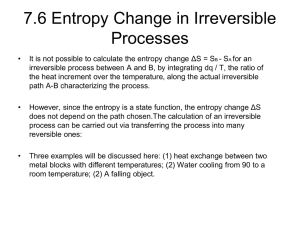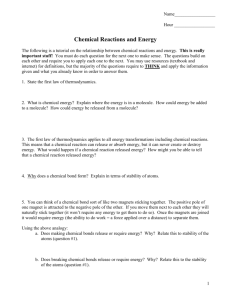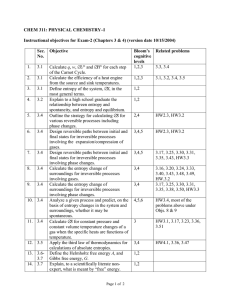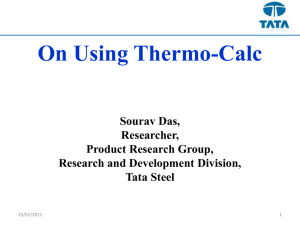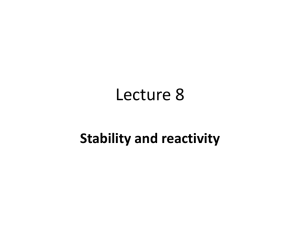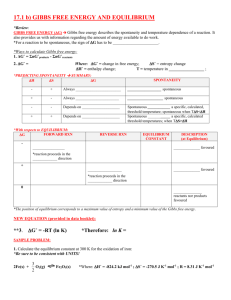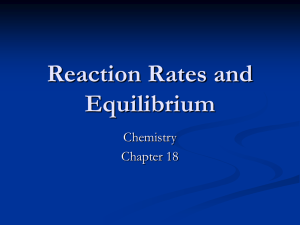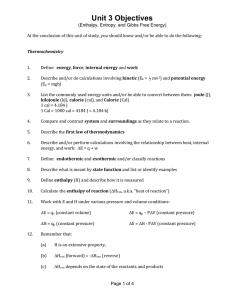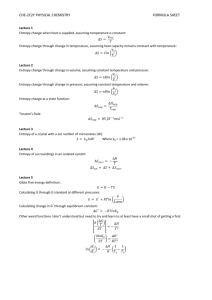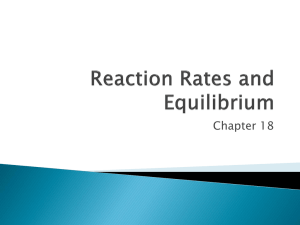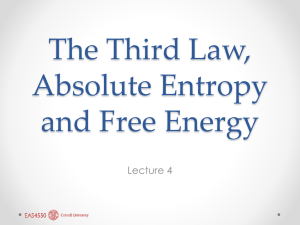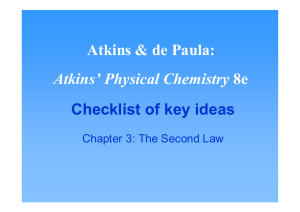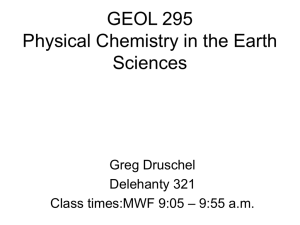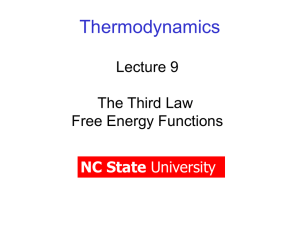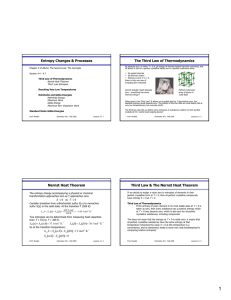Physical Chemistry Crib Sheet
advertisement
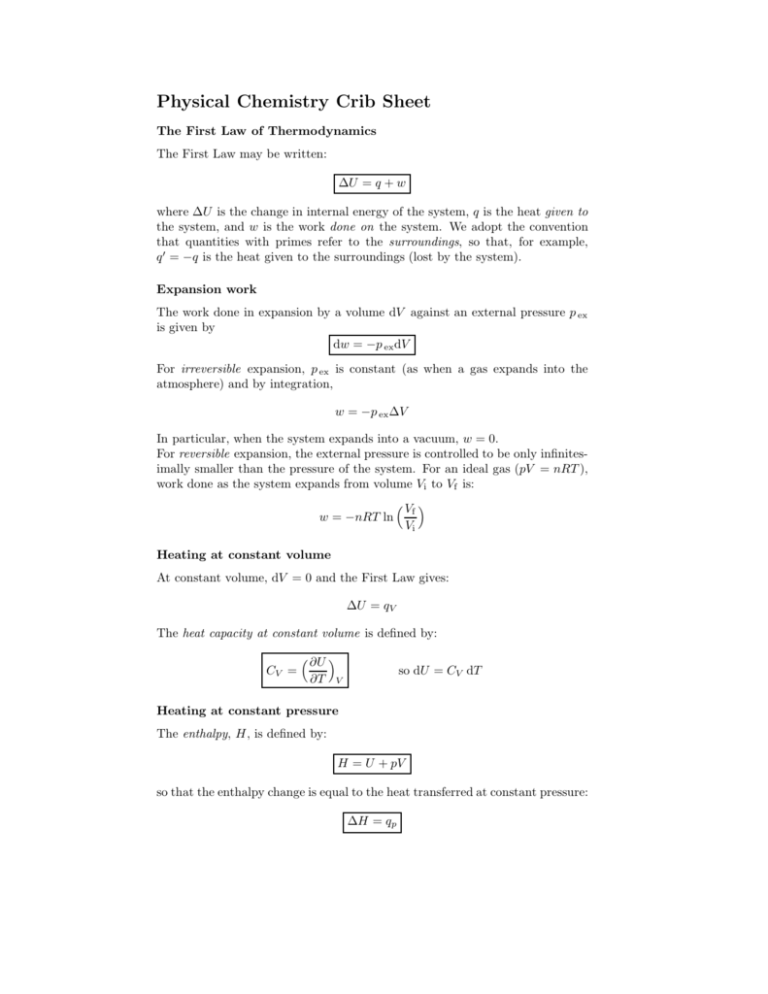
Physical Chemistry Crib Sheet The First Law of Thermodynamics The First Law may be written: ∆U = q + w where ∆U is the change in internal energy of the system, q is the heat given to the system, and w is the work done on the system. We adopt the convention that quantities with primes refer to the surroundings, so that, for example, q 0 = −q is the heat given to the surroundings (lost by the system). Expansion work The work done in expansion by a volume dV against an external pressure p ex is given by dw = −p ex dV For irreversible expansion, p ex is constant (as when a gas expands into the atmosphere) and by integration, w = −p ex ∆V In particular, when the system expands into a vacuum, w = 0. For reversible expansion, the external pressure is controlled to be only infinitesimally smaller than the pressure of the system. For an ideal gas (pV = nRT ), work done as the system expands from volume Vi to Vf is: w = −nRT ln V f Vi Heating at constant volume At constant volume, dV = 0 and the First Law gives: ∆U = qV The heat capacity at constant volume is defined by: CV = ∂U ∂T so dU = CV dT V Heating at constant pressure The enthalpy, H, is defined by: H = U + pV so that the enthalpy change is equal to the heat transferred at constant pressure: ∆H = qp For an ideal gas, since pV = nRT , and gases have a much larger volume than solids and liquids, ∆H = ∆U + ∆ng RT Where ∆ng is the change in amount (number of moles) of gas in the process. The heat capacity at constant pressure is defined by: Cp = ∂H ∂T so dH = Cp dT p For an ideal gas, it can be shown that: Cp − CV = nR Reaction enthalpies From Hess’s law (since H is a state function), any reaction enthalpy change, ∆r H , may be expressed in terms of the enthalpies of formation of the products and reactants, ∆f H : X X ν∆f H ν∆f H − ∆r H = reactants products where ν are the stoichiometric coefficients. The temperature dependence of the enthalpy of reaction is given by Kirchoff ’s Law : Z ∆r H (T2 ) = ∆r H (T1 ) + T2 ∆r Cp dT T1 where ∆r Cp = X products νCp − X νCp reactants Entropy and The Second Law The entropy of the universe never decreases in the course of all observed changes: ∆Suniv = ∆Ssys + ∆Ssurr ≥ 0 A thermodynamic definition of entropy in terms of the heat given reversibly to the system: dqrev dS = T The entropy change of a transition (e.g. vaporisation) at the transition temperature is: ∆trs H ∆trs S = Ttrs since the transition is an isothermal reversible process. The entropy change associated with the isothermal expansion of an ideal gas can be shown to be: V f ∆S = nR ln Vi The variation of entropy with temperature at constant pressure is: ∆S = Z Tf Ti Cp dT T a similar equation holding at constant volume (replace Cp with CV ). The Third Law of Thermodynamics The Nernst heat theorem: ∆S → 0 as T → 0. The Third Law Entropy is the entropy based on the convention that S(0) = 0. Calculations based on third law entropies fail to agree with measured entropies if there is some disorder in the substance at 0 K (residual entropy), so that S(0) > 0. As S is a state function, the Third Law allows ∆r Sm for a reaction may be calculated from tables of standard molar entropies: X X ∆r Sm = νSm − νSm products reactants The Gibbs and Helmholtz Free Energies The Helmholtz Free Energy, A = U − TS and the Gibbs Free Energy, G = H − TS are useful because they provide a signpost indicating the direction of spontaneous change in terms of state functions of the system only: dAT,V ≤ 0 and dGp,T ≤ 0 In particular, they define a condition for equilibrium at constant temperature and volume (dAT,V = 0) and constant temperature and pressure (dGp,T = 0). Changes in the Helmholtz and Gibbs free energies in a process are equal to the maximum work and the maximum non-expansion work respectively that a system can do: ∆A = wmax ∆G = wother,max As state functions, the changes in Gibbs and Helmholtz free energies can be calculated for (isothermal) processes by: ∆r A = ∆r U − T ∆r S ∆r G = ∆r H − T ∆r S A general change in Gibbs free energy (for a pure substance) may be written: dG = V dp − SdT so that ∂G ∂p T =V ∂G ∂T p = −S The pressure dependence of G for a perfect gas may be derived as: p f G(p f ) = G(p i ) = nRT ln pi The temperature-dependence of G, and hence for ∆G, is given by the GibbsHelmholtz equation: ∂(∆G/T ) ∆H =− 2 ∂T T p Chemical Potential and Phase Changes The chemical potential of a substance, i, in a system is defined by: µi = ∂G ∂ni p,T,nj6=i where the subscript indicates that pressure, temperature, and the amounts of all other substances present are treated as constant. In words, µi is the change in Gibbs free energy (at constant p, T ) when one mole of substance i is added to such a large mixture that the concentrations of the other substances are unaffected. The chemical potential provides the driving force towards chemical equilibrium, when µ is the same for all species present. For a pure substance, µ = Gm , the molar Gibbs free energy, and hence for an ideal gas: p µ = µ + RT ln p where µ is the standard chemical potential, that of the pure gas at p = 1 bar. A phase diagram is a plot of the phase boundaries (where µα = µβ for phases α and β in equilibrium) as they vary with p and T . The slope of these boundaries is given by the Clapeyron equation: dp ∆trs Sm = dT ∆trs Vm The Clausius-Clapeyron equation gives the temperature dependence of the vapour pressure of a substance: ∆vap H d ln p = dT RT 2 When p = p ex (e.g. the surrounding atmospheric pressure), the substance is at its boiling point. Equilibrium In general, the Gibbs free energy is a function of pressure, temperature, and the amounts of all substances present: dG = V dp − SdT + µA dnA + µB dnB + · · · Considering the simplest possible chemical process: A(g) * ) B(g) The extent of reaction, ξ, may be defined as a differential in terms of infinitesimal changes in the amounts of reactant or product: dξ = dnB = −dnA Therefore, at constant pressure and temperature, the reaction Gibbs free energy is defined as the slope of G plotted against ξ: ∆r G = ∂G ∂ξ p,T Relating ∆r G to the chemical potentials of A and B: ∆r G = µB − µA , so at equilibrium ∆r G = 0 and from the pressure-dependence of µ: p p A B − µ + RT ln 0 = µ − RT ln A B p p p A µ − µ = RT ln at equilibrium. B A pB Therefore, in terms of the equilibrium constant, K = pB /pA : ∆r G = −RT ln K This derivation generalises for reactions involving more than two species. If a species is in solution, replace pi /p with the activity, ai . K is unaffected by changes in pressure (although, of course, the equilibrium composition) may change. The van’t Hoff equation relates the effect of temperature on K: d ln K ∆r H = dT RT 2 ⇒ ln K2 − ln K1 = − 1 ∆r H 1 − R T2 T1
